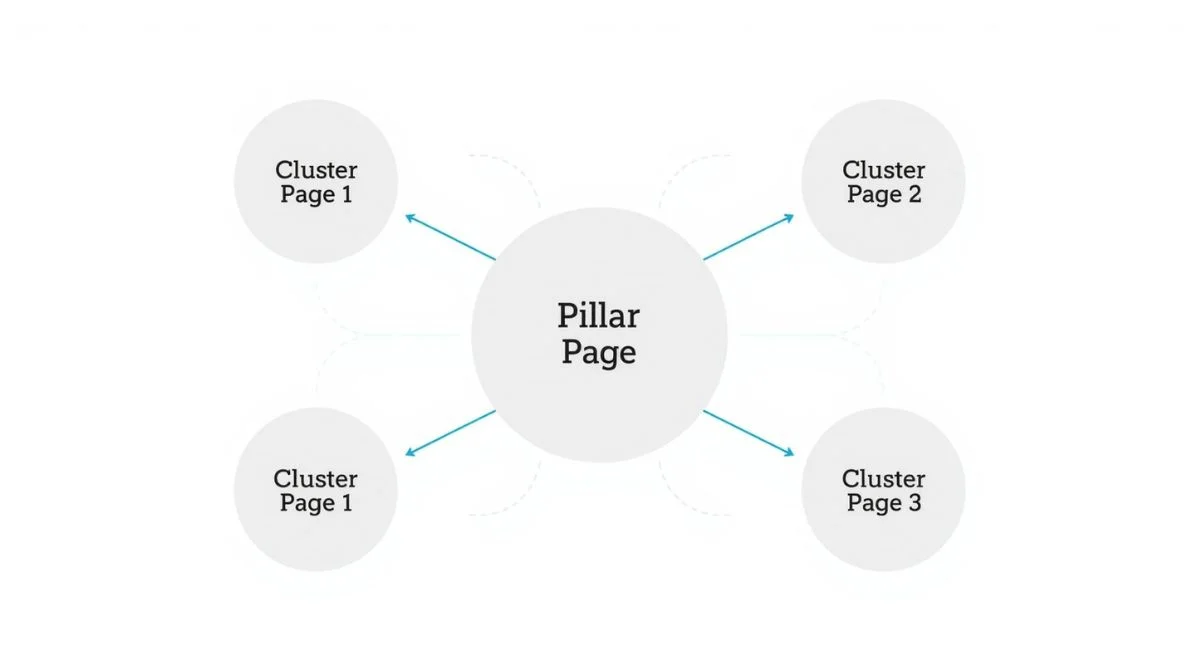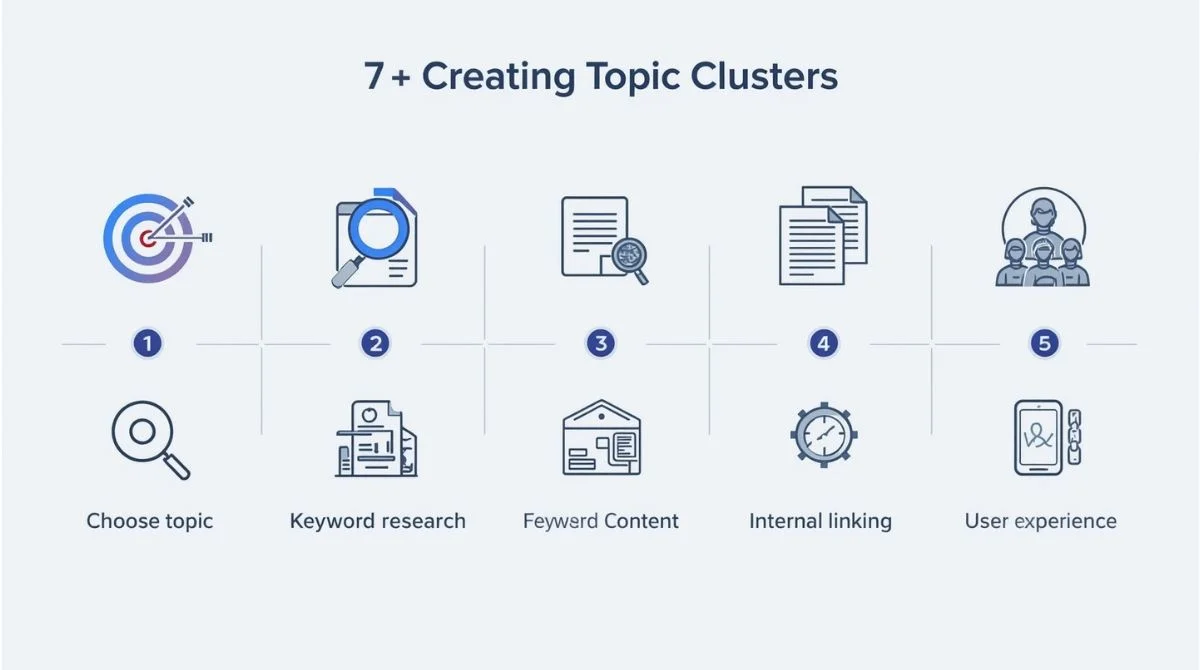What is Semantic SEO and Why Does It Matter?
Semantic SEO focuses on understanding the meaning and context behind search queries rather than just matching exact keywords. This approach helps search engines understand the relationships between different concepts and topics on your website.
In semantic SEO we optimize the content to align with the intent and meaning that lies behind search queries rather than keywords. This shift from traditional keyword-focused strategies to context-based optimization has become essential for modern SEO success.
The main benefits of semantic SEO include:
- Better understanding of user search intent.
- Improved content relevance and quality.
- Higher search engine rankings.
- Enhanced user experience and engagement.
Understanding Topic Clusters
In SEO, topic clusters are collections of interconnected pages that help demonstrate expertise on a particular subject. This content organization method creates a hub-and-spoke model where a central pillar page covers a broad topic, connected to multiple cluster pages that explore specific subtopics.
The Structure of Topic Clusters
Topic clusters consist of three main components:
- Pillar Page: The main hub that provides comprehensive coverage of a broad topic. This page should be detailed and authoritative, serving as the foundation for your cluster.
- Cluster Pages: Individual content pieces that explore subtopics connected to your main pillar page in greater detail. These pages should link back to the pillar page and to each other when relevant.
- Internal Links: Strategic connections between all pages in the cluster that help search engines understand the relationship between your content pieces.

How Semantic SEO Enhances Topic Clusters?
Topic clustering ties closely to semantic SEO, which focuses on covering every question a user might ask about a particular topic. When you combine these strategies, you create a powerful content ecosystem that satisfies search engines and users alike.
Semantic SEO improves topic clusters by:
- Creating natural keyword variations throughout your content.
- Addressing related search queries and user questions.
- Building stronger topical authority and expertise.
- Improving content depth and comprehensiveness.
Step-by-Step Guide to Creating Topic Clusters
Step 1: Choose Your Core Topic
Start by selecting a broad topic that aligns with your business goals and target audience needs. When selecting topics for your pillar content, make sure they support your business objectives and address the needs of your target audience.
Consider these factors when choosing your core topic:
- Search volume and competition level.
- Relevance to your business and expertise.
- Potential for creating multiple subtopics.
- User intent and search behavior patterns.
Step 2: Conduct Comprehensive Keyword Research
Research both primary and semantic keywords related to your chosen topic. Look for:
- Long-tail keyword variations.
- Related questions and queries.
- Synonyms and alternative phrases.
- User-generated content and forum discussions.
Use tools like Google’s “People Also Ask” feature, related searches, and keyword research platforms to identify semantic opportunities.
Step 3: Plan Your Pillar Page Content
Create a comprehensive outline for your pillar page that covers:
- Broad overview of the main topic.
- Key subtopics and their relationships.
- Frequently asked questions.
- Links to more detailed cluster pages.
Your pillar page should be substantial, typically 3,000-5,000 words, and provide real value to readers seeking information about your topic.
Step 4: Identify Cluster Page Topics
Break down your main topic into specific subtopics that deserve dedicated pages. The first step in creating good SEO topic clusters is to brainstorm broad, high-level topics to write about.
Each cluster page should:
- Focus on one specific aspect of your main topic.
- Target specific long-tail keywords.
- Provide detailed, actionable information.
- Link back to your pillar page.
Step 5: Create High-Quality Content
Develop content for each page in your cluster, ensuring:
- Comprehensive coverage of each subtopic.
- Natural integration of semantic keywords.
- Clear, readable structure with proper headings.
- Valuable insights and practical information.
Remember to write for your audience first, then optimize for search engines.
Step 6: Implement Strategic Internal Linking
Connect everything with internal links to create a strong topic cluster structure. Your linking strategy should:
- Connect cluster pages to the pillar page.
- Link related cluster pages to each other.
- Use descriptive anchor text with semantic keywords.
- Maintain a logical flow of information.
Step 7: Optimize for User Experience
As you plan your clusters and create content for every page, pay attention to the user experience. Focus on:
- Fast loading times and mobile responsiveness.
- Clear navigation between related content.
- Readable formatting with proper use of headings.
- Engaging multimedia elements when appropriate.

Advanced Semantic SEO Techniques
Entity-Based Optimization
As of 2025, the use of schema has become a common practice among SEO professionals. Leverage structured data markup to enable search engines to interpret the entities and connections within your content.
Natural Language Processing
Create content that matches how people naturally speak and search. Focus on:
- Conversational language patterns.
- Question-based content structure.
- Contextual keyword usage.
- Comprehensive topic coverage.
User Intent Alignment
A smart SEO strategy adapts to user intent, whether they’re researching, navigating to a site, or ready to buy. Ensure your content addresses different stages of the user journey.
Measuring Success
Track the performance of your topic clusters using these metrics:
- Organic traffic growth to cluster pages.
- Keyword ranking improvements.
- User engagement metrics (time on page, bounce rate).
- Internal link click-through rates.
- Conversion rates from cluster content.
Common Mistakes to Avoid
- Creating thin or duplicate content across cluster pages.
- Over-optimizing with exact-match keywords.
- Ignoring user search intent and behavior.
- Failing to update and maintain cluster content.
- Not tracking performance and making improvements.
Tools for Topic Cluster Creation
Consider using these tools to support your efforts:
- Google Search Console for keyword insights.
- SEO platforms for keyword research and tracking.
- Content management systems with strong internal linking features.
- Analytics tools for performance measurement.
Future of Semantic SEO and Topic Clusters
Topic clusters effectively address this need by forming a cohesive network of content that supports even the most intricate search journeys. As search engines continue to evolve, the importance of semantic understanding and topic authority will only increase.
Stay ahead by:
- Continuously updating your content clusters.
- Monitoring search algorithm changes.
- Adapting to new user behavior patterns.
- Investing in comprehensive content strategies.
Ready to implement topic clusters with semantic SEO for your website?
RhinoClicks offers comprehensive SEO services that include topic cluster strategy, content optimization, and performance tracking. Our expert team can help you build a content strategy that drives organic traffic and establishes your brand as an industry authority. Contact RhinoClicks today to learn how we can boost your search rankings with proven semantic SEO techniques.
Conclusion
Creating topic clusters with semantic SEO is a powerful strategy for building topical authority and improving search rankings. By understanding user intent, creating comprehensive content, and strategically linking related pages, you can develop a content ecosystem that serves both search engines and users effectively. The key to success lies in consistent execution, continuous optimization, and staying focused on providing genuine value to your audience. Start with one well-researched topic cluster, measure its performance, and gradually expand your content network.





